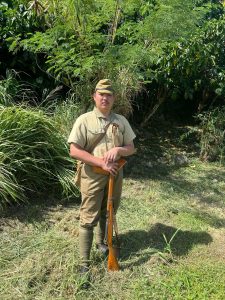Jarae Hernandez: Breathing life to history

Jarae Hernandez is dressed in full Japanese Imperial Army regalia during one of his hikes. (MARK RABAGO)
Don’t be alarmed if you come across a man in full Japanese Imperial Army regalia while you’re hiking up north. It’s just Jarae Hernandez, a 21-year-old advertising executive from Virginia who is vacationing here.
Hernandez, who studied at Saipan International School for elementary and Saipan Community School for middle school, said he dresses up in full World War II Imperial Army of Japan uniform because it’s his passion and his way of educating the public about the importance of history.
“History is my hobby. I’m currently here on vacation, and my reenactment group (Hattori Han) re-enacts the Imperial Japanese navy and army, all the way from the Russo-Japanese War to World War II,” he said.
His group has been invited to many reenactment events in the South as far as Alabama and, to his knowledge, the Hattori Han make up only a handful of Japanese Imperial military reenactment groups in the U.S.
Hernandez is especially fascinated with the Pacific War and how the Americans fought the Japanese during the Battle of Saipan.
“For Saipan specifically, I was born and raised here and have been interested in the history of Saipan for so long and I wanted to go on these hikes in full gear to truly feel what the defenders of the island had to go through, and in honor of what they did to defend Saipan,” he said.
Hernandez developed his passion for history at a young age and was even encouraged by one of the teachers at SCS, Tami Winkfield, to pursue his passion.
“Growing up on Saipan and crawling all over the tanks and cannons as a kid, I just naturally got more curious and started researching more and more. Now it has grown into archival research, collecting, and reenacting,” he said.
And the gear he wears—from the khaki shirt and pants, to the tabi shoes, and even his utility belt, rifle, and accompanying bayonet—are as close to authentic as possible.
He even confided that his helmet is actually the real deal (and even showed the marks to prove it), but his rifle is an airsoft version. “The rifle is actually a reproduction. I do have a real rifle taken from Saipan, but transporting a live firearm to Saipan can be difficult, so I purchased this airsoft one as a stand-in for now. For my uniform and gear we get from vendors all across Asia, and we try to wear as much original stuff as possible. Our puttees (leggings) are original from the ’40s, and our bayonets are original. Those are the minimum requirements as there are no good reproductions available. So it’s definitely an investment.”
Aside from the thousands of dollars he has put into the hobby, Hernandez said another challenge in being part of a reenactment group is actually finding the right size of clothing and gear as he’s 5’10” and the average Japanese soldier during World War II was between 5’4” and 5’5” so even reproduction uniforms and gear are not exactly tailor-made for his larger physique.
As for the hike he does around the island, Hernandez said he usually gravitates toward the off the beaten paths. “I tend not to follow trails and hikes since those have been explored already. So I use period photographs, or Google Earth and basically just say ‘there’ and just walk into the jungle.”
During this particular vacation alone, he already did his best Indiana Jones impersonation after finding a Japanese machine gun nest above a cliff hang some 300 meters south of the Last Command Post. His usual cave treks also unearth human remains—collar bones, ribs, and finger bones, presumably either Japanese, American, or native inhabitants.
Hernandez also has a ready answer for those who are curious about his fascination with dressing up in Imperial Japanese Army uniform as opposed to wearing the uniform of an American G.I.
“Saipan has a unique history with the Japanese as it doesn’t share the bloody history as neighboring islands or countries such as Guam and China. That’s why Saipan has a really strong connection with Japan today,” he said.
Unlike other countries that came under the yoke of Japanese imperial ambitions in World War II, he said that Saipan—as well as Tinian and Rota—was considered part of the Japanese mainland.
“Japan helped grow the economy and infrastructure of Saipan during the ’30s, and the Japanese had no bloody invasion to obtain Saipan. Of course I get comments based on the sensitivity of the Japanese, and I understand where they’re coming from. From my point of view I just like to teach history, and I like to go far into trying to understand what the average person/soldier went through,” he said.
At the end of the day, Hernandez believes his forays in full military gear in the jungles of Saipan bring him a better appreciation of the soldiers he and his Hattori Han group re-enact in the U.S. mainland.
“Doing these hikes, you figure out small things which soldiers did and why they wore things a certain way. You put something on and you’re like ‘Ah, that’s why they did that.’”























